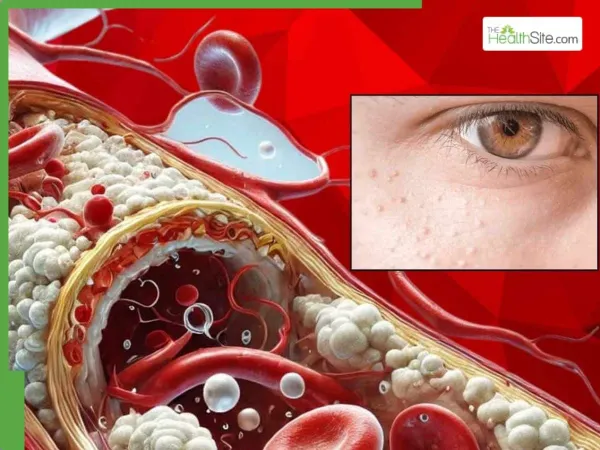
High Cholesterol Symptoms: Your eyes could be warning you about the high level of cholesterol that can be dangerous. Discover 6 unusual signs you shouldn't ignore before it's too late.
Cholesterol is a waxy, fat-like substance in the body that is important for the production of hormones, vitamin D, and bile acids, which help in the digestion of fats. Cholesterol moves throughout the body attached to lipoproteins: HDL is described as 'good' cholesterol, and LDL as 'bad' cholesterol. Generally, high cholesterol can lead to heart disease and blockage in the arteries, which hinders the blood flow. Whereas cholesterol can be processed in other parts of the body, including the eyes.
Increased levels of bad cholesterol can affect the small blood vessels and nerves in the retina, a light-sensitive layer on the back of the eye. The cholesterol deposition in these areas leads to a decrease in blood flow and causes inflammation, which results in a variety of visual impairments. And if left untreated, it may cause serious damage to the eyesight or even permanent vision loss. Recognising the effects of high cholesterol on eye health will help identify unusual signs and protect the sight from permanent damage.
6 Effects of High Cholesterol on Your Eyes: A Quiet Threat
Are you suffering from high cholesterol levels? Look out for these warning signs and symptoms in your eyes:
Xanthelasma (Yellow deposits on eyelids)
Xanthelasma is referred to as soft yellowish fatty deposits on the eyelids, right next to the eye and are harmless. However, it also indicates that cholesterol or some other lipid disorder is present. They develop slowly and will not resolve on their own. These spots remain for months or years, and they can often be your first visible sign of an elevated risk for cardiovascular disease.
Arcus senilis (a grey ring around your cornea)
It is represented by a grey or white colour ring formed around the cornea. This symptom is especially common in adults, but if you are under the age of 45 or have a high level of LDL cholesterol, then you should pay attention to it. Arcus senilis is caused due to the lipid build-ups in the cornea's blood vessels around the iris, which is a clear indication of declining cardiovascular health.
Retinal vein occlusion (Blocked retinal vessels)
Due to high cholesterol levels, plaque (fatty deposits) builds up in your retina's blood vessels and blocks them, termed as retinal vein occlusion. This blockage may lead to blurry vision or sudden loss of vision. Due to the blocked veins, pressure is built, which can damage the retina. This increases the chances of stroke or permanent vision loss.
Hollenhorst Plaques (Cholesterol Deposits in Retina)
These are light and shiny spots seen during the eye examination. These are the cholesterol emboli (fatty clots) blocking the retinal vessels, indicating that the dangerous cholesterol is moving in the bloodstream. This observation is a warning of the possibility of strokes or other serious cardiovascular diseases.
Chronic Eye Strain and Eye Discomfort
Chronic eye strain or discomfort may indicate a reduction in blood flow due to high cholesterol levels. When cholesterol deposits in the tiny vessels of the eyes, it hinders the blood flow, the delivery of oxygen decreases, and the eyes feel tired, dry, or heavy. And this may be an early sign of vascular strain in the eyes.
Sudden Vision Loss or Blurred Vision
An unexplained or sudden loss in vision, either partial or complete, could be due to the blockage caused by cholesterol in the arteries of the eyes. This indicates that the individual is facing a retinal artery occlusion, or a mini-stroke, which requires immediate medical attention. This makes it an unrecognised and serious sign of high cholesterol.
High cholesterol tends to hide in plain sight (may be in front of you, but doesn't appear until serious damage occurs), whereas your eyes could be the first place it reveals itself. From subtle discolouration to sudden changes in vision, these odd symptoms of cholesterol must not be ignored. They may seem normal at first, but they are effective risk factors for stroke, heart disease, etc. Protecting your vision can also be about protecting your life.
-
Meet actress who created history after giving three back to back Rs 500 crore blockbuster, not Deepika Padukone, Alia Bhatt, Priyanka Chopra, she is…

-
Sunjay Kapur’s third wife Priya Sachdev once revealed his marriage with Karisma Kapoor was not…, refused to become…

-
Mukesh Ambani reveals his riskiest venture, says he bet everything on…

-
Ratan Tata’s Rs 10000 crores will: shares not mentioned in it will go to…, not to Noel Tata, Leah Tata, Maya Tata or Neville Tata

-
Essel Group files plea against Kotak AMC over Rs 13 crore unpaid dues, says it didn’t honor contractual obligations
